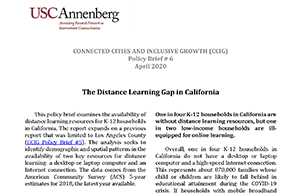CONNECTED CITIES AND INCLUSIVE GROWTH (CCIG)
Policy Brief # 6 April 2020
The Distance Learning Gap in California
This policy brief examines the availability of distance learning resources for K-12 households in California. The report expands on a previous report that was limited to Los Angeles County (CCIG Policy Brief #5). The analysis seeks to identify demographic and spatial patterns in the availability of two key resources for distance learning: a desktop or laptop computer and an Internet connection. The data comes from the American Community Survey (ACS) 5-year estimates for 2018, the latest year available.
The previous report assumed that mobile broadband services, for a variety of reasons, fall short of meeting the needs of K-12 students for distance learning. This assumption is relaxed in the current report due to the limited availability of high-speed residential Internet (e.g., DSL or cable) in many rural California communities.1 This report therefore examines the availability of distance learning resources using two different metrics:
- The share of households with a PC (desktop or laptop) and fixed (wireline) Internet service;
- The share of households with a PC (desktop or laptop) and Internet service (regardless of type of service).
Connected Cities and Inclusive Growth (CCIG) is a collaboration: USC Annenberg Research Network for International Communication (ARNIC) and the USC Price Spatial Analysis Lab (SLAB).
More information about the project can be found at arnicusc.org/research/connected-cities.

